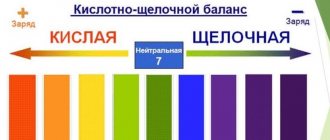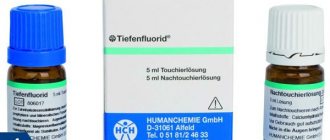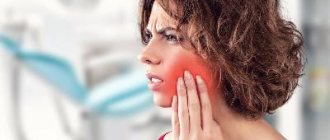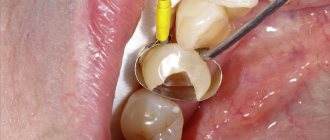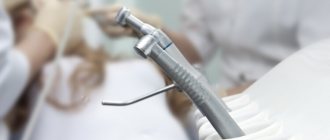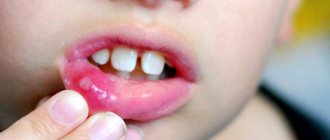During pregnancy, the expectant mother should take care not only of herself, but also of the child, because the health of the child’s teeth can be influenced even before birth.
While waiting for the baby, the expectant mother should eat a balanced diet in order to receive a sufficient amount of vitamins and microelements, and after the birth of the child, breastfeed.
It strengthens the baby's immunity and helps to develop properly. But what to do if, after the appearance of the first teeth, you notice that the enamel on children’s teeth has begun to wear off? The structure of tooth enamel contains calcium hydroxyapatite. Children have a certain supply of calcium from birth, but if it is not enough, the tooth enamel begins to deteriorate.
Tooth wear in children: causes
A child’s teeth wear out for the following reasons:
- congenital abnormal bite;
- bruxism (the child often grinds his teeth in his sleep);
- sensitive and fragile tooth enamel due to certain diseases (hypoplasia, etc.);
- genetic predisposition.
Strong abrasion of tooth enamel is caused by straight and deep bites, leading to accelerated exposure of dentin. One of the reasons for the appearance of malocclusion is disturbances in the development of the jaws, which increases the load on the teeth.
A child’s teeth can also wear out due to systemic diseases that reduce the resistance of body tissues: endocrine disorders, diseases of the central nervous system, etc.
Tooth wear can go through several stages.
Prevention of tooth decay in adults
Careful care will help keep your teeth healthy. It consists of a number of factors, including concerns about nutrition and lifestyle.
In addition, it is important to purchase:
- toothbrush, soft or medium hard. Do not forget that the brush should be changed regularly;
- threads and rinsing gels;
- toothpaste selected after consultation with a dentist.
Bad habits are worth fighting. This applies not only to smoking or alcohol, but also to clicking teeth, chewing crackers, pistachios and other hard foods.
If involuntary teeth grinding occurs, you will need the help of a neurologist. In most cases, the solution to the problem is mouthguards and sedatives (they are used only as prescribed by a doctor).
Try to enrich your diet with seafood, fresh vegetables, cottage cheese, and fruits. For rinsing (and it is better to do it after each meal), use special products. And don’t forget about the importance of preventive examination: you need to visit the dentist once every six months.
Number of views 11,371
Degrees of tooth abrasion
- Stage I – the enamel of the cutting edges of the child’s incisors and canines and the upper part of the chewing cusps and molars is erased, the dentin is partially affected.
- Stage II – severe abrasion of the chewing tubercles with exposure of dentin tissue.
- Stage III – the height of the tooth crown is reduced to 2/3 of the normal size during wear.
- Stage IV – abrasion of the tooth to the level of the neck. The crown of the tooth is almost completely erased.
If 1 – 2 teeth of a child are worn out, then this is local abrasion; if several teeth or the entire dentition are affected, then this is generalized abrasion.
If there is nothing left of the tooth
It happens that people put off visiting a doctor for so long that only emptiness remains in place of the crumbling unit. If the roots are preserved, a crown can be installed. If they are absent or are in an unsatisfactory condition for prosthetics, the patient is offered implantation. This is a dental operation during which a titanium pin is implanted into the jaw bone. After its healing, an abutment and an artificial crown are installed on top.
If the client refuses implantation, a dental bridge can be installed. But then you will have to depulp and file the healthy teeth located on both sides of the empty space.
Treat crumbling teeth on time, then you won’t have to spend a lot of time, money and effort on restoring them. At the first symptoms of a destructive process, contact your dentist.
Pathological abrasion: consequences
Pathological abrasion – rapid reduction of enamel and dentin, teeth become shorter, sensitivity increases. How to understand that tooth wear has become pathological, and what could be the consequences?
- The surface of the child’s teeth becomes distorted and destroyed, and the edges of the tooth enamel become sharp. This can injure the tongue, as well as the delicate mucous membrane of the cheeks and lips.
- The height of the teeth changes (if the disease progresses), which leads to malocclusion and deformation of the lower part of the child’s face.
- The position of the temporomandibular joint may change, and this can injure the jaw.
- The sensitivity of tooth enamel increases.
As a result, pathological abrasion of teeth occurs
The pathogenesis of the disease involves several factors, both external and internal.
| Endogenous factors | Exogenous factors |
| Metabolic disease. Gastrointestinal diseases. Pathology of the endocrine system. Bruxism (teeth grinding). | Patient's nutrition. Nature of working conditions. Incorrect prosthetics. |
The greatest influence on the abrasion process itself is exerted by occlusal forces, which have the following characteristics:
- The amount of chewing force. It is determined by the strength of the masticatory muscles, which can range from 80 to 400 kg. It is necessary to take into account that teeth are under stress not only when chewing food, but also when swallowing, and a person performs several thousand swallowing movements per day.
- Duration. During the day, the occlusal surfaces of the teeth come into contact with each other for half an hour, but with pathology, this figure can increase significantly.
- Application point and direction. The occlusal force is directed at right angles to the chewing surface of the tooth. Normally, the contact area is several square millimeters, but with pathology it can increase several tens of times, which leads to greater efforts when chewing.
In the presence of harmful production factors, bruxism, fluorosis and other reasons mentioned above, all characteristics of occlusal forces change for the worse, which leads to tooth abrasion.
What to do if your child's teeth are worn out
Treatment for tooth wear is developed individually. At the appointment, the pediatric dentist analyzes the causes of the pathology, determines the stage of erasure, the nature of the disease and the characteristics of the development of the child’s body.
What to do if your teeth start to crumble badly
The first thing you need to do is make an appointment with a dentist and come to the appointment. The doctor will conduct an in-person examination and determine the cause of the pathology. Further actions will directly depend on the provoking factor.
If it's all about caries, then it will be filled. To do this, the hole will be closed with modern filling material , which will qualitatively strengthen the walls of the crown. The patient will be told how to properly care for their oral cavity to avoid illness in the future.
If the defect occurs due to mineral deficiency, remineralization is carried out. During the procedure, the crown is treated with a special composition enriched with calcium, phosphorus and other useful compounds. Afterwards, a composite or ceramic veneer is installed to hide the chip.
If you have fluorosis, you should stop using water with a high fluoride content. Existing irregularities can be corrected using dental crowns or inlays. For minor damage, veneers and lumineers will help.
Reasons why teeth may crumble
The answer to the question of why teeth crumble in an adult or child can be not only in the field of dentistry, but also much deeper, and everything is reflected in the condition of the dentition.
Causes:
- poor
oral hygiene. And no matter how they say that everyone always talks about the importance of the procedure, it is so. An acidic environment has a destructive effect on enamel, making it fragile and vulnerable. Increased acidity is affected by plaque on the teeth, which is where bacteria and their waste products—destructive acid—accumulate; - untreated caries
and other diseases, when there is a lot of carious tissue and the walls of the tooth become thinner. As a result, the tooth began to crumble; - mechanical causes
: trauma, super-hard food - nuts, chewing candy, etc., bad habits - chewing pencils, objects, opening a bottle with your teeth. As a result, the tooth cracked and broke; - changes in
food temperature. Very hot suddenly gives way to cold. The enamel does not withstand, cracks appear; - lack of vitamins
and minerals: calcium, vitamin D (which promotes the absorption of calcium), fluorine, phosphorus; - metabolic disease
. It is worth visiting an endocrinologist; - hormonal imbalance
. These are not only diseases associated with hormonal levels and fluctuations, but also special periods in a person’s life - adolescence and old age, menopause, pregnancy; - heredity
. Genetic predisposition to weak enamel; - stress
; - malocclusion
- uneven load on the lower and upper teeth; - Bruxism
is involuntary grinding of teeth during the day or at night.
Video from our expert about how and why teeth decay:
Teeth quickly decay due to chronic diseases, diseases of the gastrointestinal tract and endocrine glands. And crumbling teeth is a signal that needs to be responded to urgently.
What causes teeth to deteriorate in adults and why they quickly decay: reasons for a ruined smile
Genetic predisposition
If you are looking for reasons why a person has bad teeth, the answer may lie in their parents.
We are talking about dental heredity, which almost always manifests itself in children both in early and adulthood. Genes determine not only the presence of a particular disease, but also predisposition to it. “Inheritance” in this case determines the following factors: the shape of the jaw system, structure, metabolism (this, in turn, directly affects the development of caries). The research results indicate that if both mom and dad had carious lesions on the upper dentition, the child will have a weaker dentition. The second conclusion is this: if the mother’s front or back teeth have deteriorated, then in 91% of cases the child will have dental problems.
Lifestyle and micronutrient deficiencies
Activities as a whole directly affect the state of the entire organism. Many professional athletes, hockey players, and boxers experience private injuries to the oral cavity, which leads to damage and defects. As a result, the teeth become loose and their position is disrupted.
Hypovitaminosis, a lack of micro-macroelements and vitamins, leads to such negative consequences as bleeding gums. To replenish the required amount of substances, dentists at Dentika recommend regularly taking synthetic drugs that cover the daily requirement. The doctor will write out the prescription at your appointment after a detailed examination.
Malocclusion
This problem occurs in most adults, but people with the most severe anomalies seek qualified treatment. This situation is extremely incorrect, since subsequent pathology leads to:
- Not equal distribution of load on chewing units during the chewing process. Some areas experience double pressure, while others are not fully involved. As a result, dental tissue deteriorates, which explains the poor condition of the front and back teeth.
- Chewing activity is reduced, since not all areas are involved. High-quality chewing dictates the need to close the jaws. But with an incorrect bite, pain and discomfort occurs. As a result, soft tissues and jaw bones are damaged.
Also one of the consequences is periodontitis. In other cases, bruxism develops (uncontrollable grinding, squeaking).
Bad habits
First of all, this is smoking and frequent drinking of alcohol. They contain large amounts of nicotine and alcohol, which negatively affects the composition of saliva (its acidity increases). As a result, the enamel is destroyed, and micropores and cracks form in the dentin.
Do not underestimate chewing laziness, which implies a reluctance to eat solid foods. Refusal of food that requires careful long-term chewing leads to disruption of the self-cleaning processes of the oral cavity. The result is periodontal damage and the development of caries.
The opposite is the habit of cracking nuts with your teeth, opening jars, and frequent use of toothpicks. These and other mechanical damage lead to the destruction of the row.
Abrasion of the enamel layer
This is a natural process, one of the companions of physiological aging. Enamel covers the crown of the tooth and is the hardest tissue in the body. Its main function is protection against chemical, physical and biological damage. If you are wondering why your teeth are deteriorating and what to do, most likely your enamel has already begun to be damaged.
A distinctive feature of tissue is that it does not have living cells. That is, if the enamel layer is worn off, it will not be restored. The first signals are detected after 40-45 years: an increase in sensitivity, an increase in the incidence of caries, a deterioration in the color of rows.
Thinning of the mucous membrane
The older a person is, the less elastic, smooth and thick this tissue is. As a result, it does not cope with protection from negative factors to the same extent. It follows from this that older people ask why their teeth suddenly began to deteriorate. In particular, with age, infectious diseases develop more often, scratches and small wounds appear, which now heal much longer and more difficult than in youth. The most common pathology caused by problems with the mucous membrane is candidiasis.

